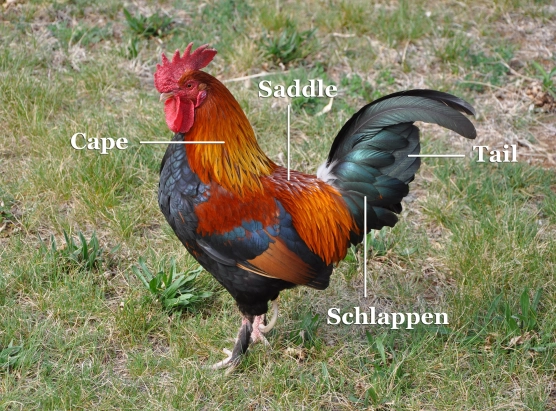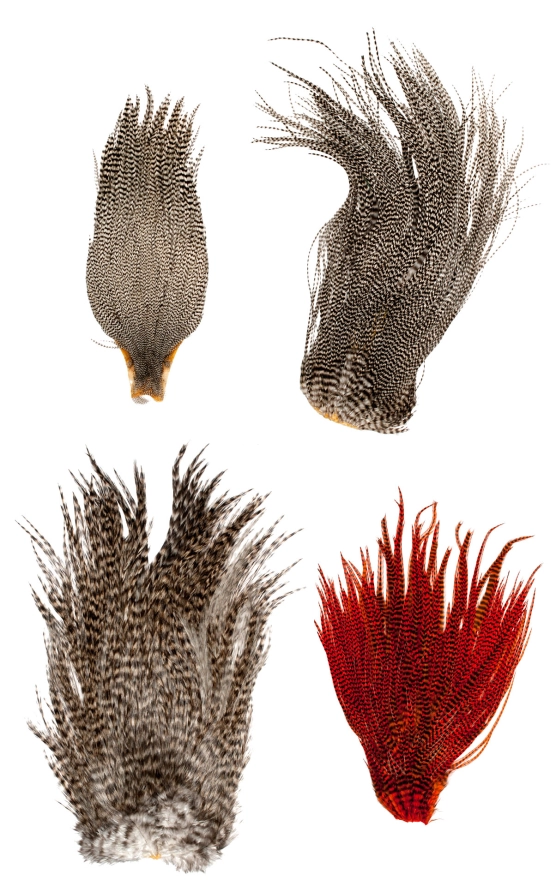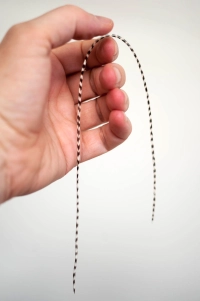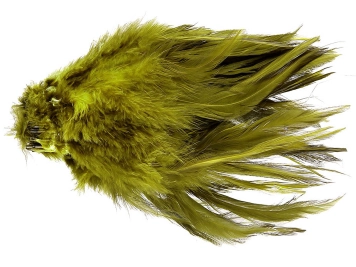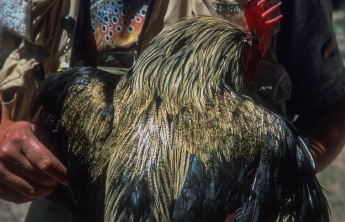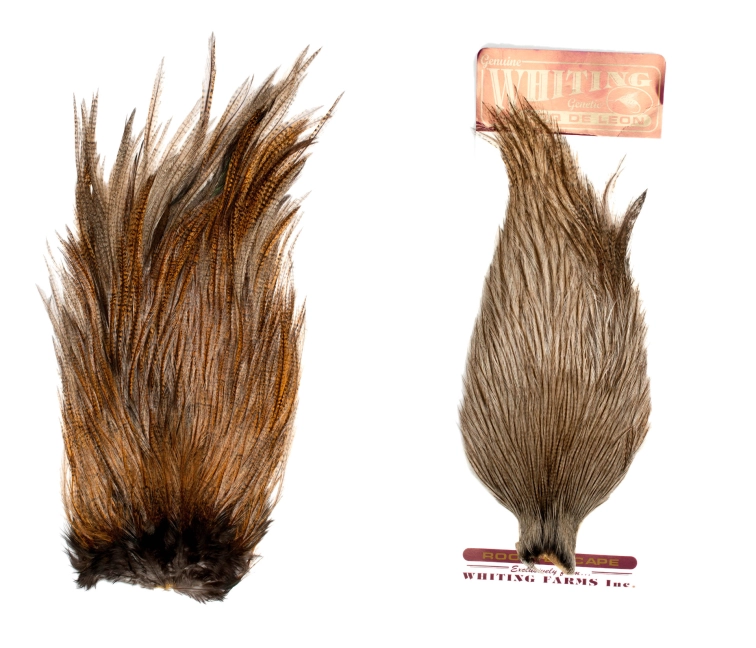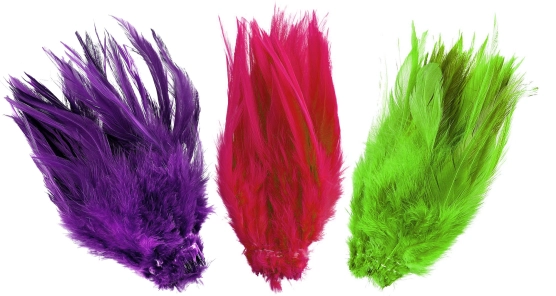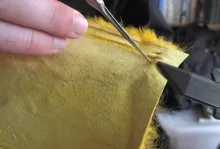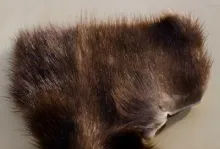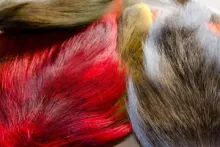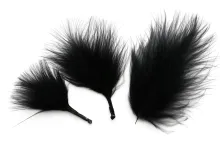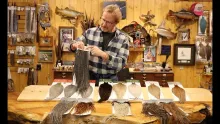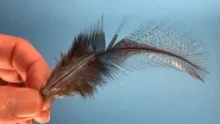What to look for when buying coarser saddle hackle - for saltwater and pike flies, for streamers, for salmon flies or other uses
Large feather rooster saddles are different beasts. We have covered the dry fly saddles in the dry fly hackle chapter of this series. This is mostly about saddle feathers for other uses like streamers, salmon, saltwater and pike flies and even tailing of dry flies. Even though some traits are the same, the feathers you want for these flies are very different from what you want for dry flies.
These saddles are often referred to as saltwater saddles or streamer saddles. They can be quite large and the feathers are mostly medium long to very long and quite larger compared to your average dry fly feather. Barbs are typically way longer and the feathers are more tapered than the very even, modern, genetic dry fly feather. These large hackle feathers used to be common and cheap because they were useless to most tyers, but these days they are sold at a premium because a lot of tyers have realized their value. The good ones are not that common and sell fast, so expect good saddles to be hard to find and fairly expensive.
They may have the word saltwater in their name - like saltwater hackle, saltwater saddles, saltwater neck hackle or whatever - but they are useful for many other types of flies too, namely featherwinged streamers, salmon and steelhead flies and pike and bass flies. You will also find some of the coarser dry fly type saddles sold under names as Euro Hackle. These are still larger and coarser than the finest genetic dry fly saddles.
Consider your needs
For hackles on salmon flies and tube flies you need large and long-barbed feathers, which is also the case if you are tying pike flies or saltwater flies such as Pete Gray's welded flies. Many low grade dry fly feathers are quite useful for these large flies, and leftover feathers from dry fly saddles and necks can often find a home on large saltwater and pike flies. The downside to the dry fly feathers is that they typically have thin and spiky barbs. In the saddle feathers we want here, the barbs are typically softer and more webby, sometimes giving the feather an almost velvet-like character.
For the traditional flatwing saltwater flies you need narrower feathers with a nice taper, soft and dense and perhaps webby so that the color or pattern on the feather will strike through.
The really large and dense saddle feathers with long fibers are usually needed by people who tie large flies, and need both long feathers, long barbs and lots of volume or color. These will often be saltwater flies, but also certain types of salmon flies as well as pike and bass flies.
In general you want thin, soft and pliable stems whether you are going to wrap the feathers as hackle or use them whole as wings, with one important exception, which is feathers for traditional New England streamers, which require a very special shape and length of feathers combined with a fairly stiff and straight stem that can hold the feather perfectly when it's tied in. Streamer tyers have special requirements, and must often go through many saddles to find one with nice and symmetrical feathers.
Dyed feathers
Like hen feathers, the rooster saddles are usually available in a very large selection of dyed colors and natural patterns. In the far majority of cases the dyeing is consistent and the colors quite beautiful, but you still want to make sure that the color is even and that the feathers will keep the color. If the color has “rubbed off” on the cardboard or even on the inside of the plastic bag, there's a risk that it hasn't been fixed properly and will come off in water. You can wash the feathers to get it out, but risk that the color fades in the process.
Rooster saddles come in a wealth of natural colors and patterns, and it pays to go through all bags to check out each, because even the same “pattern” can vary immensely from animal to animal. Some grizzly feathers are really black and white and have almost zebra quality bars, while others are grayish and more fuzzy in the pattern. Both have their applications, but they are different, and you need to select what you want and need. You can sometimes get what is referred to as "variants", which is essentially those colors that don't fit into the usual categories such as furnace, badger, dun, ginger, grizzly etc. These can sometimes be found at good prices, but will other times be more expensive than the regular colors because of their rarity.
Barb quality
The barbs vary hugely in quality and character on roosters, from very webby and velvet-like to spiky and almost glassy as it's found on Gallo de Leon birds. Most inexpensive Indian and Chinese saddles aren't that dense in the barbs, and not all of them will give character to the fly if they're wrapped as a hackle unless it's dense. Stacking these feathers for tails on pike and bass flies will often work nicely, and paired with other feathers in traditional streamer wings can often lead to good results, provided that the feathers are straight and symmetrical and have sufficiently stiff stems.
On some feathers the vane will form a solid surface, which will marry willingly, and can be hard to get to separate if the feather is wound on the hook. Others have distinctly separated barbs, which will form nice and even hackles when wrapped. If the barbs are stuck together in bunches after wrapping, combing them with Velcro or a stiff brush can have a good effect. The advantage of the denser feathers is that they add more color and character, which is desired in some flies such as some types of salmon and steelhead flies.
You will have to handle the individual saddle to assess this, and try bending the stem on several feathers to see how the barbs look and behave.
Feather length
Feather length is another aspect you need to assess and choose based on the application. Some flies and techniques call for very long and mobile feathers while others can do with shorter feathers. Most saddles have a selection of varying lengths, and can offer feathers for several purposes, while others are quite consistent in length and might not be useful for your specific purpose.
The best and highest graded, so called genetic saddles, typically have very long and uniform feathers with even barb length and consistent stem thickness. 30-40 centimeter (12-15") feathers are not uncommon on the best saddles. It's somewhat a dream to take a bunch of these and use them for a large fly, but these feathers do come at a pretty steep price, which may keep you from wanting to do that. Save the best saddles for dry flies, and use the lower grades and coarser (and less expensive) feathers for your larger flies.
Saddles sometimes have the schlappen feathers left on. These are particularly large and dense feathers that sit over the rooster's tail, and are highly appreciated by people who tie large Atlantic salmon flies and other tyers who need feathers with size and density. Many of these flies do call for long, soft and webby feathers for body hackles, and schlappen feathers meet these requirements. Sometimes useful feathers can also be found further forward on some saddles.
If you tie using the "stacking" or feather duster technique often used in pike and saltwater flies like tarpon flies, your demands might not be as high since you can add several tiled feathers to get density and volume. If your pike and saltwater flies on the other hand demand long and mobile full feathers, like on large flatwings, you might have a difficult time finding the proper saddles. These are somtimes called saltwater saddles, and are in high demand and because of that hard to find and often expensive.
When offered Chinese and Indian saddles, go through them meticulously. While the average saddle is typically short feathered with fairly stiff stems and thin, shiny and spiky barbs, you sometimes find saddles with the qualities most appreciated for streamers and large flies: dense without being webby, soft in the stems and with a good selection of long feathers. As always you need to go through the bin, get the feathers out of their bags and assess each saddle. Gems can hide in surprising places.
Sources
Like it's the case with other feathers there are many sources for saddles, ranging from the inexpensive Chinese and Indian ones to the genetically bred ones, typically coming from farms in the UK and US. As it's the case with other feathers price and quality typically follows each other. The Chinese and Indian materials can be good, but all too rarely are. They are inconsistent, often have broken barbs and/or grow marks are are not necessarily harvested at the time where the feathers are best. They can also be poorly dyed and dirty and often need some tender love and care before being useful. The brand name saddles on the other hand are typically clean, mostly flawless and with excellent dye jobs - but also expensive compared.
Gallo de Leon
These originally Spanish feathers are also known as Coq de Leon or simply CdL, and are a particular kind of feather with some very characteristic traits. They are often large and wide, although the original Spanish feathers are not as long as those currently available from sources such as Whiting Farms. The long barbs are shiny, almost glassy, and are used on generic Spanish flies where the barbs are cut off the feather and tied in in bunches and spun to form swept back hackles on the traditional Spanish wet fly patterns. Even when tied in this way, the hackles are often quite long on the finished flies, and long barbs is a desired property on these saddles. In Spain the feathers are often "harvested" off the living rooster, and the rooster lives on to produce more feathers. The feathers are sold in small bunches of hand picked quality, often with a dozen or so mounted on cardboard.
The most common commercially available Gallo de Leon feathers are from Whiting Farms in the US, and they are sold as traditional saddles from skinned birds. These feathers are large and wide, and have found use in many contemporary patterns like saltwater streamers and shrimp flies, and are also popular as tailing material on dry flies. Whiting also sells pack of individual feathers in so called Tailing Packs.
Strung feathers
If you are hackling or using the feathers for wings that require less consistency and quality – like on pike flies – you can often use so called strung hackle, which is feathers plucked off the skin and bundled or bagged. These are also sometimes called schlappen feathers mentioned above. Strung hackle isn't necessarily schlappen – in fact it rarely is – but the name has stuck as a general term for large and webby saddle feathers.
Strung feathers vary a lot in consistency and quality, and as always it's important to get them out of the bag and scrutinize them. Variation can be nice, but if you are looking for many identical feathers for a row of identical flies, variation isn't exactly welcome.
Watch out for
You need to watch out for the banes of feather materials: Growth marks, broken feathers and undeveloped feathers.
Growth marks appear as banding on some or many of the feathers on certain individual birds. It's a result of uneven growth of the feather, and can be seen as stripes where the barbs are less dense, thinner and shinier than on the rest of the feather. These marks will lead to discarding many feathers and should be avoided.
Broken feathers and barbs are pretty obvious, and are simply feathers where barbs or tips are broken off. This can be caused by the animal plucking itself or being plucked by its brethren, but can also be the result of the feathers being old and dry or having been roughly handled in the preparation and cleaning process. You can use a saddle with feathers with broken barbs, but just not for hackling where the shorter barbs will give an uneven and ugly looking hackle.
Undeveloped feather can be a problem. Feathers have a growing season, and when the bird sheds the old feathers and start growing new, a lot of the feathers will be inside a sheath where it develops before emerging as a fully developed feather. You want to avoid skins where a lot of the feathers are still in these sheaths, simply because you will have less feathers to use. Luckily skins with many undeveloped feathers are rare, because most breeders know exactly when to harvest for the optimal number and quality of feathers during the season.
As always: clean is good
Of course you have to look for the same things as you do with all natural materials: dust, dirt and grease – as well as surplus dye. Get the saddles as clean and nice as you can find them, but consider giving them a soapy wash and some conditioner when you have brought them home. Or at least steam them. That can do wonders, and sometimes save even the worst bargain bin find.
- Log in to post comments

